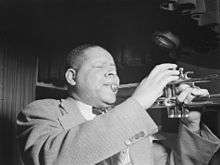Red Allen
| Red Allen | |
|---|---|
 | |
| Background information | |
| Birth name | Henry James Allen |
| Also known as | "Red" |
| Born |
January 7, 1908 Algiers, Louisiana, United States |
| Died |
April 17, 1967 (aged 59) New York City, New York, United States |
| Genres | Jazz |
| Occupation(s) | Trumpeter |
| Instruments | Trumpet |
| Years active | 1924–1967 |
| Associated acts | King Oliver, Clarence Williams, Steve Lacy |
Henry James "Red" Allen (January 7, 1908 – April 17, 1967) was a jazz trumpeter and vocalist whose style has been claimed to be the first to fully incorporate the innovations of Louis Armstrong.[1]
Life and career
Allen was born in the Algiers neighborhood of New Orleans, Louisiana, the son of the bandleader Henry Allen. He took early trumpet lessons from Peter Bocage and Manuel Manetta.
Allen's career began in Sidney Desvigne's Southern Syncopators. He was playing professionally by 1924 with the Excelsior Brass Band and the jazz dance bands of Sam Morgan, George Lewis and John Casimir. After playing on riverboats on the Mississippi River, he went to Chicago in 1927 to join King Oliver's band. Around this time he made recordings on the side in the band of Clarence Williams. After returning briefly to New Orleans, where he worked with the bands of Fate Marable and Fats Pichon, he was offered a recording contract with Victor Records and went to New York City, where he joined the Luis Russell band, which was later fronted by Louis Armstrong in the late 1930s.[2]
In 1929 Allen joined Luis Russell's Orchestra, in which he was a featured soloist until 1932. He took part in recording sessions that year organized by Eddie Condon, some of which featured Fats Waller and Tommy Dorsey. He also made a series of recordings in late 1931 with Don Redman. In 1933 he joined Fletcher Henderson's Orchestra, in which he stayed until 1934. He played with Lucky Millinder's Mills Blue Rhythm Band from 1934 to 1937, when he returned to Russell for three more years, by which time Russell's orchestra was fronted by Louis Armstrong. Allen seldom received any solo space on recordings with Armstrong but was prominently featured in the band's live performances, even getting billing as a featured attraction.
As a bandleader, Allen recorded for Victor from 1929 through 1930. He made a series of recordings as co-leader with Coleman Hawkins in 1933 for ARC (Banner, Melotone, Oriole, Perfect, Romeo, etc.) and continued as an ARC recording artist through 1935, when he was moved to ARC's Vocalion label for a popular series of swing records from 1935 through late 1937. A number of these were popular at the time. He did a solitary session for Decca in 1940 and two sessions for OKeh in 1941. After World War II, he recorded for Brunswick in 1944, Victor in 1946, and Apollo in 1947.
Allen continued making many recordings under his own name and also with Fats Waller and Jelly Roll Morton and accompanied such vocalists as Victoria Spivey and Billie Holiday. After a short stint with Benny Goodman, Allen started leading his own band at the Famous Door in Manhattan. He then toured with the band around the UNited States into the late 1950s.
In December 1957, Allen made a memorable appearance along with Pee Wee Russell on the television program "Sound Of Jazz". In 1959 he made his first tour of Europe when he joined Kid Ory's band. He led the house band at New York's famous Metropole Cafe from 1954 until the club ceased its jazz policy in 1965.
Death
Allen returned to working under his own name and made numerous tours of the United States and Europe. He was diagnosed with pancreatic cancer in late 1966. After undergoing surgery, he made a final tour of England, which ended six weeks before his death, on April 17, 1967, in New York City. He was survived by his widow, Pearly May, and a son, Henry Allen III.
Style and influence
Red Allen's trumpet style has been described, by some critics, as the first to fully incorporate the innovations of Louis Armstrong and to develop an emphasis on phrasing.[3] Allen's recordings received much favorable attention. His versatility is shown by his winning of Down Beat awards in both the traditional jazz and the modern jazz categories.
Discography
- Red Allen, Kid Ory & Jack Teagarden at Newport (Vereve, 1957)
- World on a String (RCA Victor, 1957), originally released as Ride, Red, Ride in Hi-Fi
- Mr. Allen (Swingville, 1962)
- The College Concertm with Pee Wee Russell (Impulse!, 1966)
- Jazz Standards and Warhorses, with Coleman Hawkins (Jass Records, CD version 1987)
- 1929–1933 (Chronological Classics 540, 1990)
With Langston Hughes
- Weary Blues (MGM, 1959)
References
- ↑ Cook, Richard (2005). Richard Cook's Jazz Encycolpedia. London: Penguin Books. p. 9. ISBN 0-141-00646-3.
- ↑ Collier, James Lincoln (1985). Louis Armstrong. Pan Books. p. 294. ISBN 0-330-28607-2.
- ↑ Berendt, Joachim (1976). The Jazz Book. Paladin. pp. 187–188.
Further reading
- Ride, Red, Ride – The Life of Henry "Red" Allen by John Chilton, Continuum, 1999. ISBN 0-304-70407-5
External links
| Wikimedia Commons has media related to Henry "Red" Allen. |